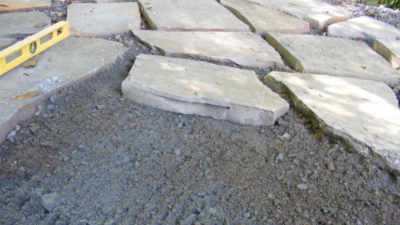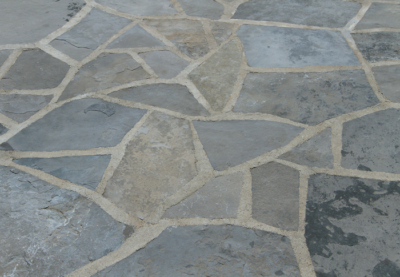May 27, 2025
BURLINGTON, ON
Flagstone patios are timeless. Natural, durable, and undeniably charming, they bring texture and personality to any outdoor space. But even the most beautiful surfaces aren’t immune to wear and tear. One day you’re sipping coffee on your back patio, and the next—crack. A hairline split turns into a spiderweb. Suddenly, your yard’s crown jewel doesn’t feel so flawless.
If you’ve noticed cracks forming and don’t know where to start, you’re not alone. Early flagstone repair can save time, money, and the overall look of your landscape. And understanding what causes flagstone to crack in the first place? That’s the first real step toward a lasting fix.
What Makes Flagstone Special—and Vulnerable
Flagstone isn’t just one kind of stone. It’s a group. Sandstone, slate, limestone, and bluestone all fall under its umbrella. These sedimentary rocks split naturally along flat planes, creating those iconic slabs we all know and love.
But here’s the catch: flagstone’s beauty lies in its irregularities. Each piece is unique—formed by nature, not a machine. That natural appeal also comes with quirks. Some stones are denser. Some absorb more water. Some handle cold like champs, while others crumble under frost.
Translation? Even when installed perfectly, flagstone isn’t invincible.
It performs well under the right conditions. But add moisture, shifting ground, or repeated pressure, and cracks become part of the story.
Freeze-Thaw Cycles: The Silent Saboteur
Live in a region with cold winters? This one’s for you.
Moisture is a flagstone’s best friend and worst enemy. Water seeps into tiny pores and settles into joints. When temperatures drop, that water freezes. And when it freezes? It expands—like popcorn in a microwave.
Crack. Pop. Push. That expansion places stress on the stone, causing splits, flakes, or full-on breaks. It can lift slabs from their bedding, shift joints, and widen existing cracks in just a few freeze-thaw cycles.
Over time, even the toughest flagstone can’t stand up to the pressure. Especially if it wasn’t sealed or graded correctly.
The result? A once-smooth surface starts to feel more like a jigsaw puzzle.
Improper Installation: A Faulty Foundation
Even the best flagstone needs a good base. Without one, it’s like building a castle on sand.
Many cracks trace back to poor installation. Weak bedding layers, loose subgrade, or the wrong mortar can set the stage for disaster.
Sometimes installers cut corners with materials. Skipping gravel layers. Using thin mortar. Failing to compact the soil. It saves time upfront—but costs more later when the stones shift, settle, or break.
Think of flagstone like a puzzle laid over a trampoline. If the base isn’t solid, pieces will move—and eventually crack under pressure.
A proper foundation should include compacted base gravel, bedding sand or mortar, and solid edge restraints. Anything less, and you’re walking on borrowed time.
Heavy Loads and Repeated Pressure
Flagstone isn’t made for everything. Yes, it’s sturdy. But it’s not concrete.
Driveways, heavy furniture, large grills, or frequent foot traffic in tight areas can cause stress. Over time, that pressure leads to hairline fractures that deepen with each season.
Even smaller issues add up. A wheelbarrow rolling over the same joint. Patio chairs scraping back and forth. The repetitive motion works like erosion—small changes, day by day, until something finally gives.
To keep your flagstone patio intact, distribute weight evenly. Use protective pads under furniture. Avoid placing heavy objects on unsupported slabs. And most importantly, install stones thick enough to handle their environment.
Water Drainage and Erosion
Water is nature’s sculptor. Left unchecked, it carves, shifts, and moves everything in its path—including your patio.
Poor drainage is one of the biggest culprits behind flagstone damage. Water that pools under or around your stonework gradually erodes the bedding layer. As the support weakens, stones sink or tilt. The added movement increases the chances of cracking.
Erosion around edges also leads to exposed joints and shifting stones. And if the joints aren’t sealed or filled correctly? Water goes straight down—and the cycle begins.
Simple fix? Grade your patio correctly. Water should always flow away from the structure, never toward it. Add perimeter drains or French drains if necessary. And maintain joint integrity by checking and refilling regularly.
Age, Weathering, and Natural Wear
Even the best-built patios eventually show their age. Flagstone may last decades—but like anything exposed to the elements, it weathers.
Sunlight fades colors. Wind and rain wear down edges. Freeze-thaw cycles slowly chip and crack. It’s not neglect—it’s nature doing its thing.
Older patios may also have outdated materials. Mortars used 20 years ago weren’t always flexible or weather-resistant. Today’s products are designed to move with the stone, not fight against it.
So if your flagstone has seen a few decades, minor cracks could simply be age lines. Not a crisis—just a sign it’s ready for a bit of love.
What to Do About Cracked Flagstone
Now for the good part—what you can actually do.
Inspect and identify.
Start with a close look. Are the cracks deep or superficial? Are they isolated to one area or spreading? Check the joints, edges, and slope. Understanding the cause helps guide the solution.
Repoint joints.
Loose or crumbling mortar can often be replaced without removing whole stones. This not only improves appearance but helps prevent water intrusion.
Replace damaged stones.
If a stone is beyond saving, lift it out and install a new one. Make sure the base is leveled and compacted before placing the replacement.
Seal selectively.
Not every flagstone needs sealing—but in damp or high-traffic areas, a breathable sealer can help prevent moisture damage without trapping water beneath.
Improve drainage.
Sometimes the fix isn’t the stone—it’s the slope. Adjust grading, add drains, or reshape the layout so water flows properly.
Call in pros when needed.
If cracking is widespread or your patio feels unstable, it’s best to bring in a team that specializes in flagstone repair. They’ll assess the problem from the ground up and offer long-term solutions.
Preventing Future Cracks: A Smarter Approach
Prevention is always easier than repair. And luckily, keeping flagstone in shape isn’t rocket science.
Sweep regularly. Remove debris that holds moisture. Keep an eye on drainage after heavy rain. Use pads under furniture. And every few years, inspect your joints and re-fill where required.

Check the qualifications of the people doing the installation. If you’re doing it yourself – read up before starting.
When installing new flagstones, insist on proper grading and base layers. Choose thicker stones for high-traffic areas. And don’t forget to ask about frost-proof mortars or sand blends if you live in a freeze zone.
A little effort now saves a lot of work later.
Flagstone may crack—but that doesn’t mean it’s broken. Like any natural material, it needs a bit of care, some smart design, and the occasional fix to stay beautiful.
The good news? Every repair is a chance to improve. Stronger joints. Better drainage. A more durable surface that lasts longer and looks even better.
If your patio’s showing signs of age or damage, don’t wait for a bigger problem. The experts at GTA Sunrise know flagstone inside and out. With the right tools, trained hands, and an eye for detail, they’ll bring your outdoor space back to life—stone by stone.




















Leave a Reply